At this stage almost everyone will have heard of mica. For some it’s a passing problem they come across intermittently. For others it consumes their whole lives.
But what exactly is mica? And what consequences does it have for those living with it?
Mica is the name given to a group of minerals found in rocks. Mica, specifically muscovite mica, has led to defects in building blocks in at least 5,000 homes, primarily in the north-west of the country.
The blocks used to build these homes contain disproportionately high levels of mica. Over time this causes the blocks – when they come into contact with moisture – to crack and crumble. Building blocks comprised of no more than 1% mica are safe.
The minute you cross into the county, the problem is evident everywhere
Donegal is the epicentre of the mica crisis as many of the affected blocks were produced in the county. While national media attention has increased over the past two years, the problem has been there for well over a decade.
The minute you cross into the county, the problem is evident everywhere. There are signs on the roads and stickers on cars highlighting the problem and calling for redress. Houses affected by mica are visible driving around the countryside, with every village and town affected to some degree within homes, commercial or community buildings.
A scheme announced by the Government gave 90% redress to mica homeowners, with a cap of €275,000 on building works. Protests calling for 100% redress ensued. An updated scheme is expected to be announced in the coming weeks.
While mica homeowners await the details of this enhanced scheme, we spoke to two Donegal farming families about their experience of living in homes affected by mica.
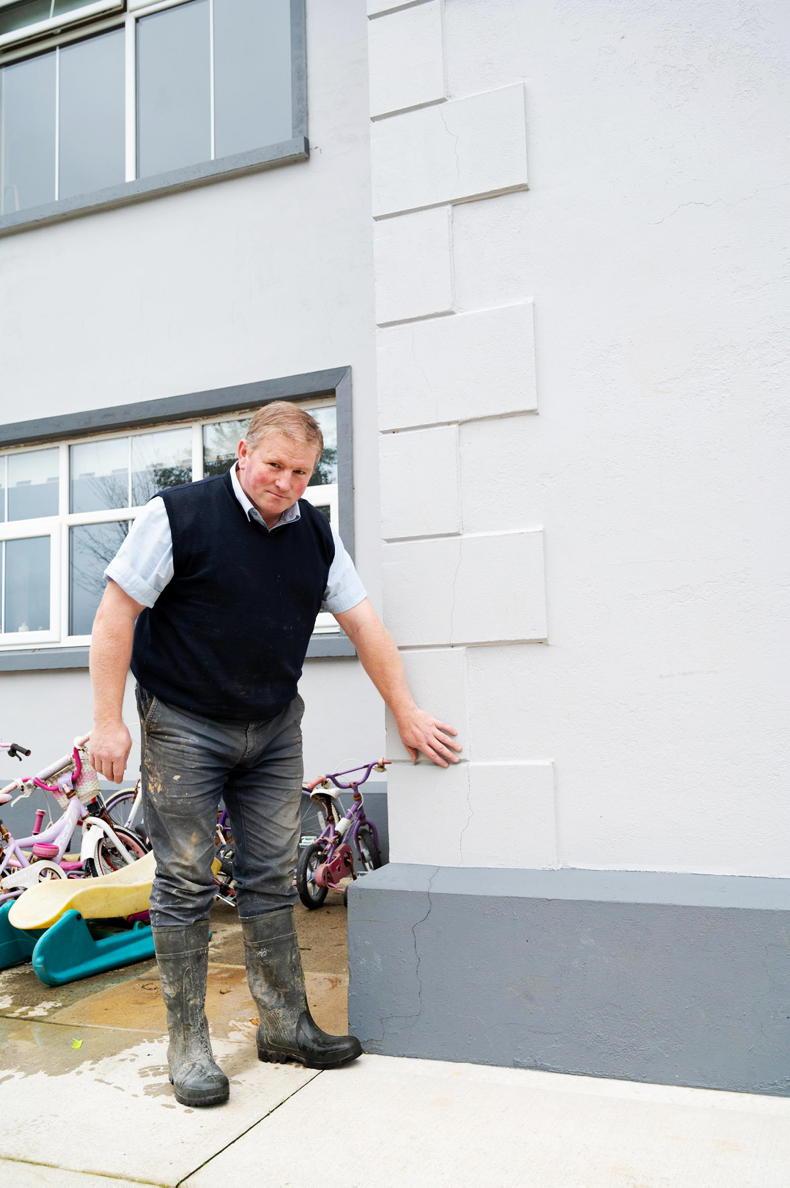
John Holmes showing cracking caused by mica on his house in Donegal. \ Clive Wasson
Manorcunningham, Co Donegal
Undoubtedly, the financial cost of mica is huge. However, so too is the human cost. Living in Manorcunningham, just outside Letterkenny, Co Donegal, John Holmes’ home is affected by mica.
He and his wife have three young children. It’s stark when you notice the children worrying about mica, John says. Recently they went to put a picture up on the wall and their youngest daughter asked them not to, in case hammering in the nail caused the wall to crumble.
John is a tillage and sheep farmer, growing grain and potatoes. He also has a headstone business.
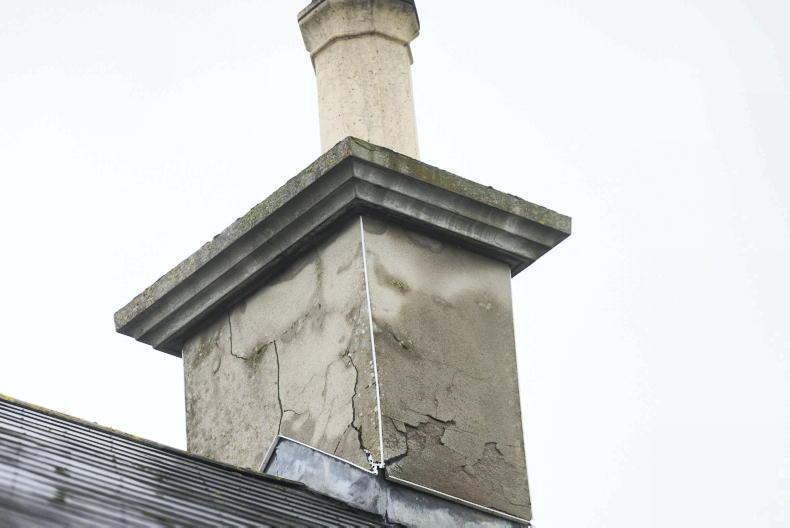
A chimney badly effected by mica on John Holmes house in Donegal. \ Clive Wasson
He feels it’s difficult for people not from Donegal to fully grasp the severity of the mica problem in the county and how widespread it is. Sometimes, this can even be the case from place to place within the county.
“We went for a drive one Sunday to the top of Inishowen. We were on a road I’d never been on before, from Moville out around Glengad to go across to Malin.
“That’s only 30 or 40 miles away and I was shocked at how many mica houses there are there. So I couldn’t imagine how someone from Kerry or Limerick or Wexford could fully appreciate it, when I was here keeping myself abreast of all the developments and yet when I went for a run on a Sunday evening I was shocked.”
Cracks begin to show
John’s house was built in 2006 and 2007. It was 2014 when he first noticed the cracks beginning to show.
“In 2014 there wasn’t the same awareness of mica,” he says. “I saw the cracks before I knew anything about mica. I just thought to myself, it’s a bad plaster job.”
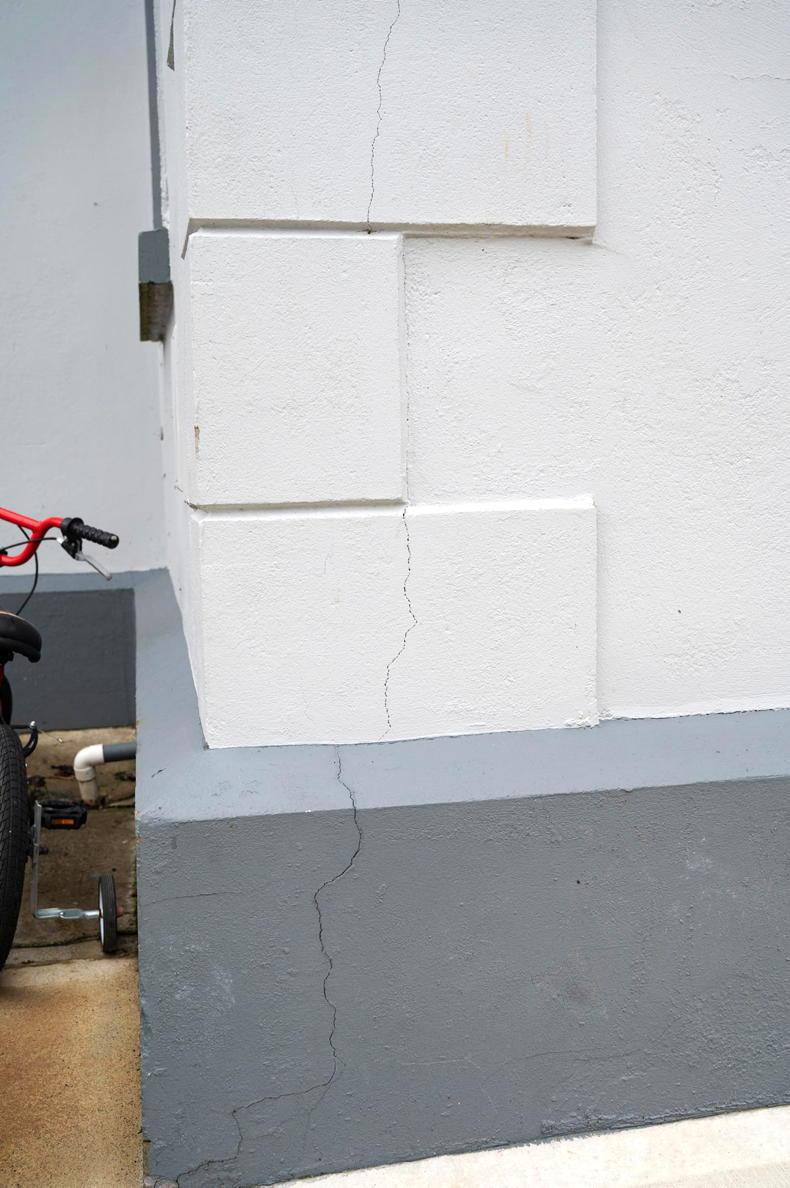
Cracking caused by mica on John Holmes's house in Donegal. \ Clive Wasson
It was only in the last two years John realised his home was affected by mica. The house has cracking on the outer-leaf and upstairs inside, as well as paint disturbance on the two chimney breasts inside. John has done some work to repair the outside of the house.
As mica reacts with moisture, painting and plastering can slow down the deterioration of the blocks. He filled in the cracks and repainted the house. At an initial glance you mightn’t notice the cracking, but when you look it’s there.
It was recommended in John’s case that the outer leaf of the house be replaced, as well as repair work upstairs inside. Demolition wasn’t recommended as the base blocks tested OK
To apply for the redress scheme for mica, known officially as the Defective Concrete Block Grant Scheme, you need an engineer’s report to prove your house has mica. This cost John €6,300, which needed to be paid upfront. It can be claimed back under the scheme. Core samples are taken from the walls and from the base blocks.
It was recommended in John’s case that the outer leaf of the house be replaced, as well as repair work upstairs inside. Demolition wasn’t recommended as the base blocks tested OK.
The cap
If John’s house was recommended for a full rebuild, the cost of this likely wouldn’t be covered under any version of the redress scheme. As 100% redress looks likely to be announced in the next iteration of the scheme, the cap on the cost of works is one of the issues under discussion by Government.
Reports in recent weeks said Cabinet was considering a €400,000 cap for the updated version of the scheme to be announced soon, but this is yet to be confirmed
In the first version of the scheme the cap was €275,000 for grant aid to demolish and rebuild a house. Figures for rebuilding a house range from between €110 and €160 per square foot. John’s house is 5,000 square feet. Even using the lower end of the scale, a rebuild would cost €550,000.
Reports in recent weeks said Cabinet was considering a €400,000 cap for the updated version of the scheme to be announced soon, but this is yet to be confirmed.
Looking forward
John is hoping to apply under the updated redress scheme and begin work on the house next spring. The family are planning to live downstairs while the work is taking place.
He has yet to get a formal quote for work from a builder. An informal quote, however, put the cost of the work at roughly €180,000.

Cracking caused by mica on John Holmes's house in Donegal. \ Clive Wasson
Overall, John feels with the changes expected to be announced under the new redress scheme will be fair.
But still, that doesn’t take away the associated stress.
“It’s definitely a very stressful situation. I’d be thinking to myself, how’s it going to be financed? But I don’t get too bothered about it at the same time. I know there’s a very generous redress scheme and it will work itself out. Still, it’s a stress you don’t need.”
Reflecting on the mica situation and the blocks that put them in this position in the first place, John feels there was a regulatory failing.
“This scheme, I’ll have to avail of it to fix my house. But it makes me angry now to think that the State is going to have to spend billions and billions over the failings of regulations.”

Mark and Irene Geogehan outside their house affected by mica. \ Clive Wasson
Newtowncunningham, Co Donegal
Mark and Irene Geoghegan spent seven years living in “the wee house”, a prefabricated home on their farm in Newtowncunningham, Co Donegal. During this time they were saving to build their dream house, now located just a short distance away. Mark is a suckler and sheep farmer and Irene is an optician.
They decided to take their time building this house. They wanted to do things properly, putting themselves and their daughter Kate in a good position for the future.
For example, while a 100mm cavity wall was what was required at the time, they put in a 150mm cavity with beaded insulation for extra warmth, as well as underfloor heating.
The house was built in 2007. In March 2022 their mortgage on this house will be paid off. Unfortunately though, this house is going to have to be demolished, because it has mica.

Irene and Mark Geogehan showing cracking and moss caused by mica on their house in Donegal. \ Clive Wasson
The first indication that something was wrong was in 2012 when moss began to grow on the outer walls, on top of and through the paint. In 2014 they had the house washed and repainted. The moss grew back quickly, Irene says. “We talked to different people, Colour Trend, Dulux and all of them. We were asking, ‘What do we do to get the paint to last and stay on the house?’”
When cracks began to show, they thought there was something wrong with the plaster work.
Suspicions
Around this time they started asking more questions as mica was beginning to be talked about. They took out a sample of their blocks and showed it to an engineer. The engineer said at the time that even after three weeks in a warm house the sample was still wet to the touch.

Internal cracks caused by mica at Mark and Irene Geogehan's house. \ Clive Wasson
“He put it in writing then to say that from the physical inspection he felt it was mica. But he suggested that we maintain and repaint the house,” Irene says.
Which they did. They washed the house once again with hydrochloric solution, filled in the cracks and painted it once more in 2018.
In early 2019 cracks started showing inside the house. Mark still thought it would be a case of replacing the outer leaf and patching up inside where needed.
Then last summer he went to visit a friend. His house had mica. This made him rethink the severity of their own problem. “I went out to the house and I said, ‘Oh sweet Jesus we’ve a problem ourselves.’ I said, ‘Who’s your engineer?’ He said, ‘There’s her number.’ I rang her and she came down here. She just looked up and said, ‘Yeah, you have it.’”
That was October 2020.
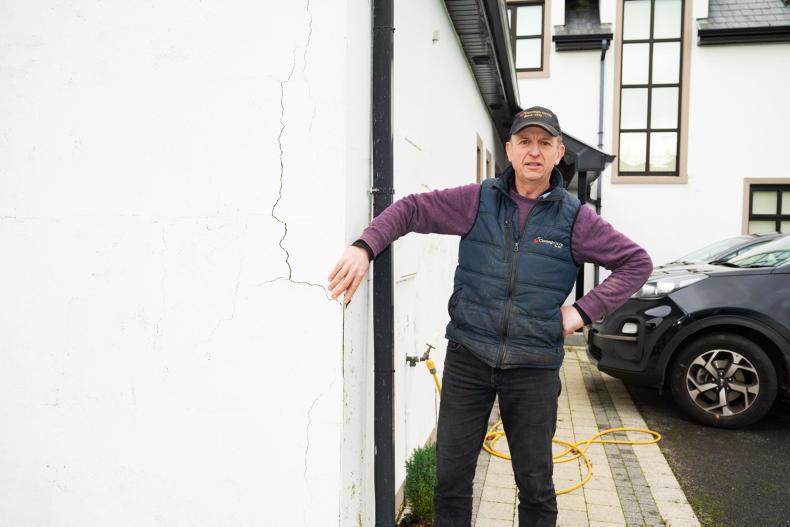
Mark Geogehan showing cracking on his house caused by mica. \ Clive Wasson
The test to assess the level of mica in their blocks cost them €6,300. Their results came back at the beginning of 2021. Mark was shocked at how bad they were.
“The engineer said, ‘They’re as bad as I’ve seen and I can’t believe it because your house is one of the better ones I’ve looked at. I’ve seen houses much worse with better results,’” Mark says.
Weetabix blocks
The results for the blocks came back as critical. Some of the samples tested had mica concentration levels as high as 36.6%. Remember, building blocks comprised of no more than 1% mica are safe. Any higher, then they shouldn’t be used in construction.
The engineer’s report subsequently recommended full demolition.
Mark and Irene feel the good insulation and heating in the house helped slow the degradation of the blocks.
“They talk about Weetabix blocks,” Irene says. “That is a really good analogy. Weetabix blocks would be every bit as useful as what we have, because there’s zero strength left in our blocks and they deteriorate with age.
“It’s the speed at which the cracks are appearing and progressing. You do see it. Maybe not week-on-week, but you do see it month-on-month that there is a significant deterioration. For example, the crack on the gable end, I can put the car key right into it. At the start I couldn’t put my nail into it.”
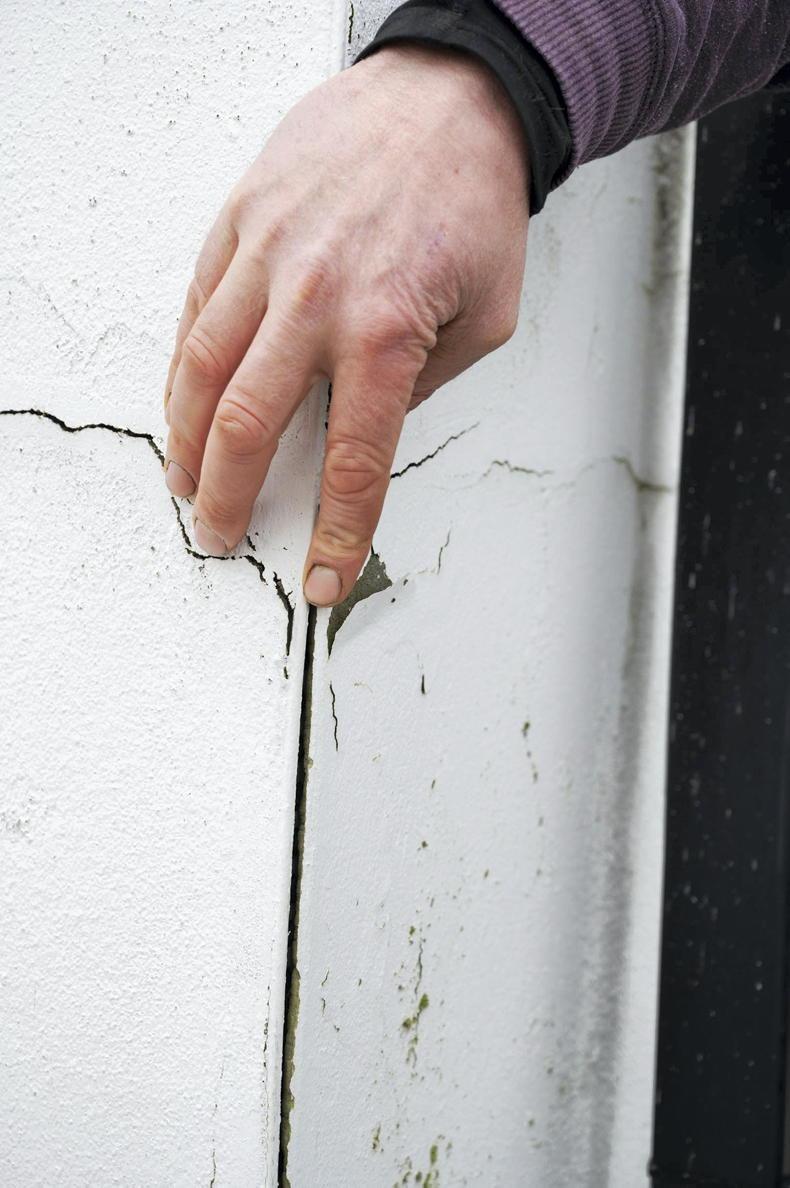
Cracking caused by mica on Mark and Irene Geogehan's house in Donegal. \ Clive Wasson
In the interim they have applied to Donegal County Council for the redress scheme. In August of this year they were approved for stage one. They are now working on plans for a new house, which will have the same footprint but will be a smaller build, as the scheme, even if a higher cap is approved, will not cover the cost of rebuilding the house as it stands. Then they will reapply for planning permission.
The redress scheme only relates to the structure of the house. That means at present, everything from your kitchen to your light switches needs to be kept to be reused again. This will all need to be stored somewhere safe and dry. Mark and Irene rebuilt their mica-affected shed and put heating in it for this purpose.
The Geoghegans experienced many sleepless nights and much stress
The cost of demolition is included in the redress money. For Irene and Mark, this means the cost of removing the beaded insulation they put in. The materials will also have to be disposed of.
And where are they going to live while all this is going on? The wee house, which they do feel lucky to have.
The Geoghegans experienced many sleepless nights and much stress. They put a ban on the word “mica” after a certain time in the evening.
Injustice
They discuss fondly the things they’ll miss about this house in its current format, particularly the view.
Irene as always is pragmatic: “This is a first-world problem. You turn around and say, ‘If Kate was sick this wouldn’t be a problem.’
“Nothing would be an issue then,” Mark interjects.
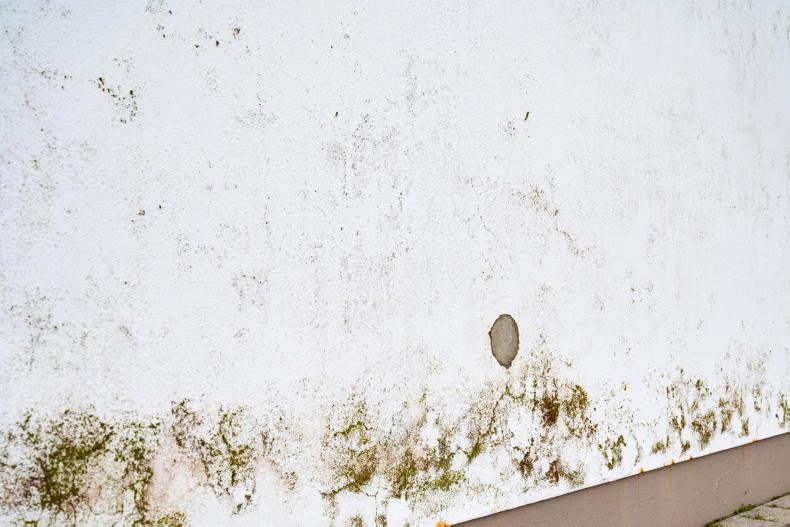
Cracking and moss caused by mica on Mark and Irene Geogehan's house in Donegal. \ Clive Wasson
Irene continues: “My grandfather often said, ‘It’s only a problem if money and time won’t fix it.’ God willing, we’ll have the time and we’ll find the money, but we shouldn’t have to do this.”
As a farmer whose animals are held to the highest regulatory standards, the injustice gets to Mark too. “It goes back to the same thing at the end of the day. If we produce cattle and there’s anything wrong, the Department are sitting on top of us. There was no one overseeing this and there are still question marks.”
At present the Defective Concrete Blocks Grant Scheme only covers principal private dwellings. For example, commercial and public buildings are not included, but many in affected areas have mica. Also, the scheme can only be applied for through Mayo County Council and Donegal County Council. Other counties with mica and pyrite affected homes, such as Limerick, Clare, Tipperary and Sligo, are looking to be included in the scheme. There are also suspected mica cases in Northern Ireland.
Read more
INHFA campaigns for Mica redress scheme
Farm sheds ‘crumbling’ from mica in Donegal
At this stage almost everyone will have heard of mica. For some it’s a passing problem they come across intermittently. For others it consumes their whole lives.
But what exactly is mica? And what consequences does it have for those living with it?
Mica is the name given to a group of minerals found in rocks. Mica, specifically muscovite mica, has led to defects in building blocks in at least 5,000 homes, primarily in the north-west of the country.
The blocks used to build these homes contain disproportionately high levels of mica. Over time this causes the blocks – when they come into contact with moisture – to crack and crumble. Building blocks comprised of no more than 1% mica are safe.
The minute you cross into the county, the problem is evident everywhere
Donegal is the epicentre of the mica crisis as many of the affected blocks were produced in the county. While national media attention has increased over the past two years, the problem has been there for well over a decade.
The minute you cross into the county, the problem is evident everywhere. There are signs on the roads and stickers on cars highlighting the problem and calling for redress. Houses affected by mica are visible driving around the countryside, with every village and town affected to some degree within homes, commercial or community buildings.
A scheme announced by the Government gave 90% redress to mica homeowners, with a cap of €275,000 on building works. Protests calling for 100% redress ensued. An updated scheme is expected to be announced in the coming weeks.
While mica homeowners await the details of this enhanced scheme, we spoke to two Donegal farming families about their experience of living in homes affected by mica.

John Holmes showing cracking caused by mica on his house in Donegal. \ Clive Wasson
Manorcunningham, Co Donegal
Undoubtedly, the financial cost of mica is huge. However, so too is the human cost. Living in Manorcunningham, just outside Letterkenny, Co Donegal, John Holmes’ home is affected by mica.
He and his wife have three young children. It’s stark when you notice the children worrying about mica, John says. Recently they went to put a picture up on the wall and their youngest daughter asked them not to, in case hammering in the nail caused the wall to crumble.
John is a tillage and sheep farmer, growing grain and potatoes. He also has a headstone business.

A chimney badly effected by mica on John Holmes house in Donegal. \ Clive Wasson
He feels it’s difficult for people not from Donegal to fully grasp the severity of the mica problem in the county and how widespread it is. Sometimes, this can even be the case from place to place within the county.
“We went for a drive one Sunday to the top of Inishowen. We were on a road I’d never been on before, from Moville out around Glengad to go across to Malin.
“That’s only 30 or 40 miles away and I was shocked at how many mica houses there are there. So I couldn’t imagine how someone from Kerry or Limerick or Wexford could fully appreciate it, when I was here keeping myself abreast of all the developments and yet when I went for a run on a Sunday evening I was shocked.”
Cracks begin to show
John’s house was built in 2006 and 2007. It was 2014 when he first noticed the cracks beginning to show.
“In 2014 there wasn’t the same awareness of mica,” he says. “I saw the cracks before I knew anything about mica. I just thought to myself, it’s a bad plaster job.”

Cracking caused by mica on John Holmes's house in Donegal. \ Clive Wasson
It was only in the last two years John realised his home was affected by mica. The house has cracking on the outer-leaf and upstairs inside, as well as paint disturbance on the two chimney breasts inside. John has done some work to repair the outside of the house.
As mica reacts with moisture, painting and plastering can slow down the deterioration of the blocks. He filled in the cracks and repainted the house. At an initial glance you mightn’t notice the cracking, but when you look it’s there.
It was recommended in John’s case that the outer leaf of the house be replaced, as well as repair work upstairs inside. Demolition wasn’t recommended as the base blocks tested OK
To apply for the redress scheme for mica, known officially as the Defective Concrete Block Grant Scheme, you need an engineer’s report to prove your house has mica. This cost John €6,300, which needed to be paid upfront. It can be claimed back under the scheme. Core samples are taken from the walls and from the base blocks.
It was recommended in John’s case that the outer leaf of the house be replaced, as well as repair work upstairs inside. Demolition wasn’t recommended as the base blocks tested OK.
The cap
If John’s house was recommended for a full rebuild, the cost of this likely wouldn’t be covered under any version of the redress scheme. As 100% redress looks likely to be announced in the next iteration of the scheme, the cap on the cost of works is one of the issues under discussion by Government.
Reports in recent weeks said Cabinet was considering a €400,000 cap for the updated version of the scheme to be announced soon, but this is yet to be confirmed
In the first version of the scheme the cap was €275,000 for grant aid to demolish and rebuild a house. Figures for rebuilding a house range from between €110 and €160 per square foot. John’s house is 5,000 square feet. Even using the lower end of the scale, a rebuild would cost €550,000.
Reports in recent weeks said Cabinet was considering a €400,000 cap for the updated version of the scheme to be announced soon, but this is yet to be confirmed.
Looking forward
John is hoping to apply under the updated redress scheme and begin work on the house next spring. The family are planning to live downstairs while the work is taking place.
He has yet to get a formal quote for work from a builder. An informal quote, however, put the cost of the work at roughly €180,000.

Cracking caused by mica on John Holmes's house in Donegal. \ Clive Wasson
Overall, John feels with the changes expected to be announced under the new redress scheme will be fair.
But still, that doesn’t take away the associated stress.
“It’s definitely a very stressful situation. I’d be thinking to myself, how’s it going to be financed? But I don’t get too bothered about it at the same time. I know there’s a very generous redress scheme and it will work itself out. Still, it’s a stress you don’t need.”
Reflecting on the mica situation and the blocks that put them in this position in the first place, John feels there was a regulatory failing.
“This scheme, I’ll have to avail of it to fix my house. But it makes me angry now to think that the State is going to have to spend billions and billions over the failings of regulations.”

Mark and Irene Geogehan outside their house affected by mica. \ Clive Wasson
Newtowncunningham, Co Donegal
Mark and Irene Geoghegan spent seven years living in “the wee house”, a prefabricated home on their farm in Newtowncunningham, Co Donegal. During this time they were saving to build their dream house, now located just a short distance away. Mark is a suckler and sheep farmer and Irene is an optician.
They decided to take their time building this house. They wanted to do things properly, putting themselves and their daughter Kate in a good position for the future.
For example, while a 100mm cavity wall was what was required at the time, they put in a 150mm cavity with beaded insulation for extra warmth, as well as underfloor heating.
The house was built in 2007. In March 2022 their mortgage on this house will be paid off. Unfortunately though, this house is going to have to be demolished, because it has mica.

Irene and Mark Geogehan showing cracking and moss caused by mica on their house in Donegal. \ Clive Wasson
The first indication that something was wrong was in 2012 when moss began to grow on the outer walls, on top of and through the paint. In 2014 they had the house washed and repainted. The moss grew back quickly, Irene says. “We talked to different people, Colour Trend, Dulux and all of them. We were asking, ‘What do we do to get the paint to last and stay on the house?’”
When cracks began to show, they thought there was something wrong with the plaster work.
Suspicions
Around this time they started asking more questions as mica was beginning to be talked about. They took out a sample of their blocks and showed it to an engineer. The engineer said at the time that even after three weeks in a warm house the sample was still wet to the touch.

Internal cracks caused by mica at Mark and Irene Geogehan's house. \ Clive Wasson
“He put it in writing then to say that from the physical inspection he felt it was mica. But he suggested that we maintain and repaint the house,” Irene says.
Which they did. They washed the house once again with hydrochloric solution, filled in the cracks and painted it once more in 2018.
In early 2019 cracks started showing inside the house. Mark still thought it would be a case of replacing the outer leaf and patching up inside where needed.
Then last summer he went to visit a friend. His house had mica. This made him rethink the severity of their own problem. “I went out to the house and I said, ‘Oh sweet Jesus we’ve a problem ourselves.’ I said, ‘Who’s your engineer?’ He said, ‘There’s her number.’ I rang her and she came down here. She just looked up and said, ‘Yeah, you have it.’”
That was October 2020.

Mark Geogehan showing cracking on his house caused by mica. \ Clive Wasson
The test to assess the level of mica in their blocks cost them €6,300. Their results came back at the beginning of 2021. Mark was shocked at how bad they were.
“The engineer said, ‘They’re as bad as I’ve seen and I can’t believe it because your house is one of the better ones I’ve looked at. I’ve seen houses much worse with better results,’” Mark says.
Weetabix blocks
The results for the blocks came back as critical. Some of the samples tested had mica concentration levels as high as 36.6%. Remember, building blocks comprised of no more than 1% mica are safe. Any higher, then they shouldn’t be used in construction.
The engineer’s report subsequently recommended full demolition.
Mark and Irene feel the good insulation and heating in the house helped slow the degradation of the blocks.
“They talk about Weetabix blocks,” Irene says. “That is a really good analogy. Weetabix blocks would be every bit as useful as what we have, because there’s zero strength left in our blocks and they deteriorate with age.
“It’s the speed at which the cracks are appearing and progressing. You do see it. Maybe not week-on-week, but you do see it month-on-month that there is a significant deterioration. For example, the crack on the gable end, I can put the car key right into it. At the start I couldn’t put my nail into it.”

Cracking caused by mica on Mark and Irene Geogehan's house in Donegal. \ Clive Wasson
In the interim they have applied to Donegal County Council for the redress scheme. In August of this year they were approved for stage one. They are now working on plans for a new house, which will have the same footprint but will be a smaller build, as the scheme, even if a higher cap is approved, will not cover the cost of rebuilding the house as it stands. Then they will reapply for planning permission.
The redress scheme only relates to the structure of the house. That means at present, everything from your kitchen to your light switches needs to be kept to be reused again. This will all need to be stored somewhere safe and dry. Mark and Irene rebuilt their mica-affected shed and put heating in it for this purpose.
The Geoghegans experienced many sleepless nights and much stress
The cost of demolition is included in the redress money. For Irene and Mark, this means the cost of removing the beaded insulation they put in. The materials will also have to be disposed of.
And where are they going to live while all this is going on? The wee house, which they do feel lucky to have.
The Geoghegans experienced many sleepless nights and much stress. They put a ban on the word “mica” after a certain time in the evening.
Injustice
They discuss fondly the things they’ll miss about this house in its current format, particularly the view.
Irene as always is pragmatic: “This is a first-world problem. You turn around and say, ‘If Kate was sick this wouldn’t be a problem.’
“Nothing would be an issue then,” Mark interjects.

Cracking and moss caused by mica on Mark and Irene Geogehan's house in Donegal. \ Clive Wasson
Irene continues: “My grandfather often said, ‘It’s only a problem if money and time won’t fix it.’ God willing, we’ll have the time and we’ll find the money, but we shouldn’t have to do this.”
As a farmer whose animals are held to the highest regulatory standards, the injustice gets to Mark too. “It goes back to the same thing at the end of the day. If we produce cattle and there’s anything wrong, the Department are sitting on top of us. There was no one overseeing this and there are still question marks.”
At present the Defective Concrete Blocks Grant Scheme only covers principal private dwellings. For example, commercial and public buildings are not included, but many in affected areas have mica. Also, the scheme can only be applied for through Mayo County Council and Donegal County Council. Other counties with mica and pyrite affected homes, such as Limerick, Clare, Tipperary and Sligo, are looking to be included in the scheme. There are also suspected mica cases in Northern Ireland.
Read more
INHFA campaigns for Mica redress scheme
Farm sheds ‘crumbling’ from mica in Donegal














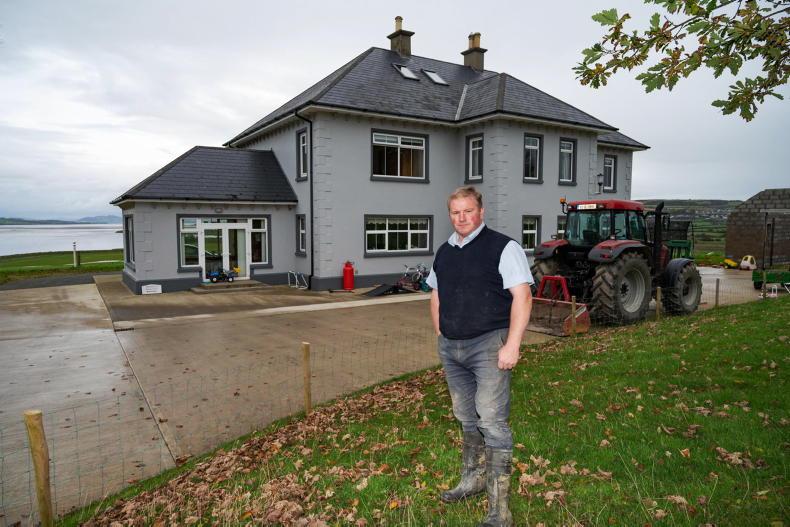
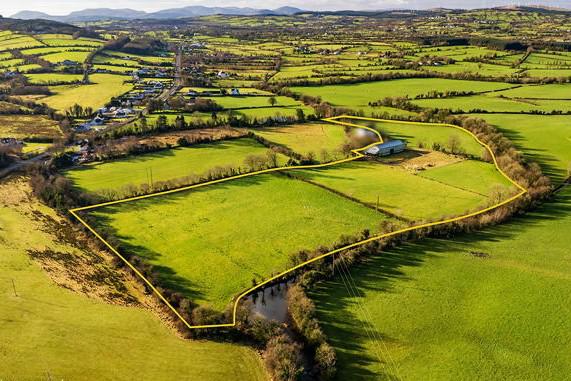



SHARING OPTIONS